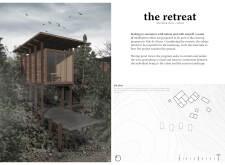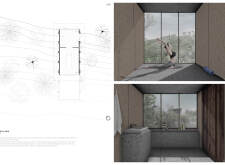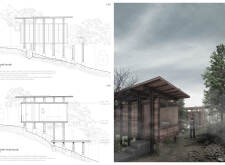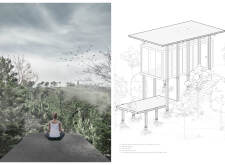5 key facts about this project
The architectural approach of The Retreat emphasizes a seamless connection to the surrounding environment. Each cabin is elevated on slender wooden columns, which minimizes the impact on the terrain and preserves natural vegetation. This design technique not only reduces soil erosion but also facilitates the continuous growth of flora beneath the cabins. The cabins are oriented to optimize views and natural light while protecting occupants from harsh weather conditions.
The materiality of The Retreat plays a crucial role in its overall aesthetic and sustainability. The primary materials used include wood, concrete, glass, rubber, and photovoltaic panels. Wood is extensively utilized for structural elements, creating a warm and inviting atmosphere. Concrete forms the foundation, providing stability and durability. Large glass windows serve to enhance connectivity with the outdoors, allowing natural light to flood the interior spaces and offering occupants panoramic views of the surrounding landscape. The incorporation of rubber in the acoustic design enhances the peaceful ambiance, essential for a meditation environment. Photovoltaic panels are integrated into the design to promote renewable energy use, ensuring a lower environmental impact.
Sustainability is a central theme in the design of The Retreat. The project implements a gravity-fed gray water system, responsibly managing water resources while maintaining the ecological balance of the site. This thoughtful integration of sustainable practices demonstrates a commitment to environmental stewardship.
The uniqueness of The Retreat lies in its adaptive use of the landscape and emphasis on user experience. The architectural design respects the site’s topography, creating a series of interconnected cabins that allow for communal interaction while providing individual spaces for meditation. The straightforward geometry reflects a modern aesthetic that complements its natural setting. Each cabin is designed to facilitate a diverse range of mindfulness activities while ensuring minimal distraction from nature.
In conclusion, The Retreat manifests a coherent architectural vision that prioritizes harmony with the environment, mindful design, and sustainable living. For those interested in detailed architectural insights, including architectural plans, architectural sections, and innovative architectural ideas, exploration of the project presentation is highly encouraged.


























